
Global antimicrobial susceptibility testing market is estimated to be valued at USD 4.21 Bn in 2025 and is expected to reach USD 6.72 Bn by 2032, exhibiting a compound annual growth rate (CAGR) of 6.9% from 2025 to 2032.
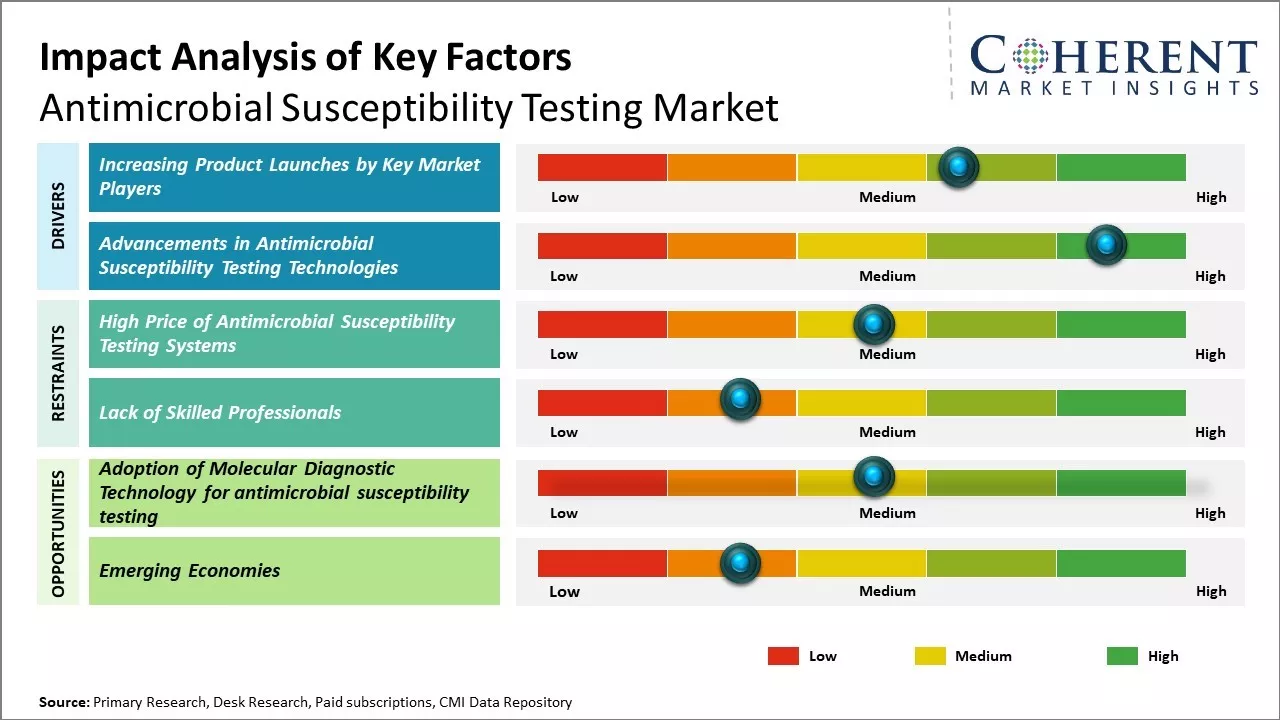
Discover market dynamics shaping the industry: Download Free Sample
The global antimicrobial susceptibility testing market is expected to grow steadily owing to the rising prevalence of hospital-acquired infections and increasing antibiotic resistance worldwide. Furthermore, the growing need to manage antimicrobial resistance and optimize antibiotic usage is expected to drive the demand for antimicrobial susceptibility testing products and services. Technological advancements in susceptibility testing platforms introducing automation and faster time-to-results will also support the market growth over the forecast period.
Increasing Product Launches by Key Market Players
Increasing adoption of inorganic growth strategies, such as product launches, by key market players is expected to drive the market growth over the forecast market. For instance, Sysmex Corporation, a medical technology company, announced that it had launched point-of-care testing system in Europe to detect antimicrobial susceptibility in just 30 minutes. The system detects the presence or absence of bacteria and assesses the effectiveness of antimicrobials using urine samples from patients suspected of having urinary tract infections (UTIs). Using a unique and proprietary microfluidic technology, the system delivers antimicrobial susceptibility testing (AST). It results in as little as 30 minutes from the start of measurement, a significant reduction compared to the several days required for conventional AST.
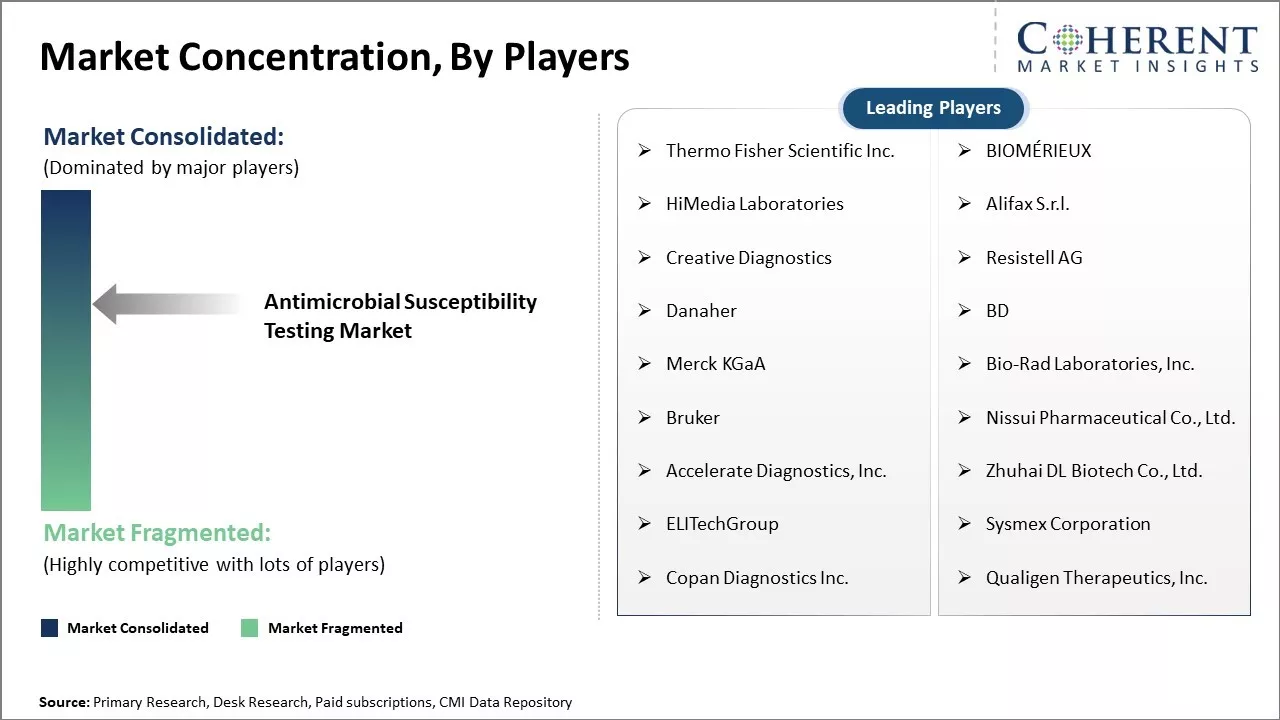
Get actionable strategies to beat competition: Download Free Sample
Advancements in Antimicrobial Susceptibility Testing TechnologiesAdvancements in molecular diagnostic techniques and automation technologies are revolutionizing the field of antimicrobial susceptibility testing. Traditional AST methods based on culture and phenotypic identification are being replaced by rapid diagnostic tests that detect genetic markers of drug resistance directly from clinical samples. Technologies, such as polymerase chain reaction (PCR), DNA microarrays, mass spectrometry, and whole genome sequencing, are enabling the detection of resistance within hours instead of days. At the same time, fully automated systems for AST are reducing turnaround time and labor, improving efficiency as well as standardization of test results. This shift from conventional methods to innovative diagnostic platforms is propelling the antimicrobial susceptibility testing market growth. Diagnostic companies are continuously launching simple, user-friendly systems suitable for routine testing in core laboratories as well as point-of-care testing. The development of platforms that integrate sample-to-result workflow and provide results comparable to reference methods is enhancing the AST uptake significantly. Thus, technological evolution is a key driver as it addresses some of the limitations of existing methods improving antibiotic stewardship.
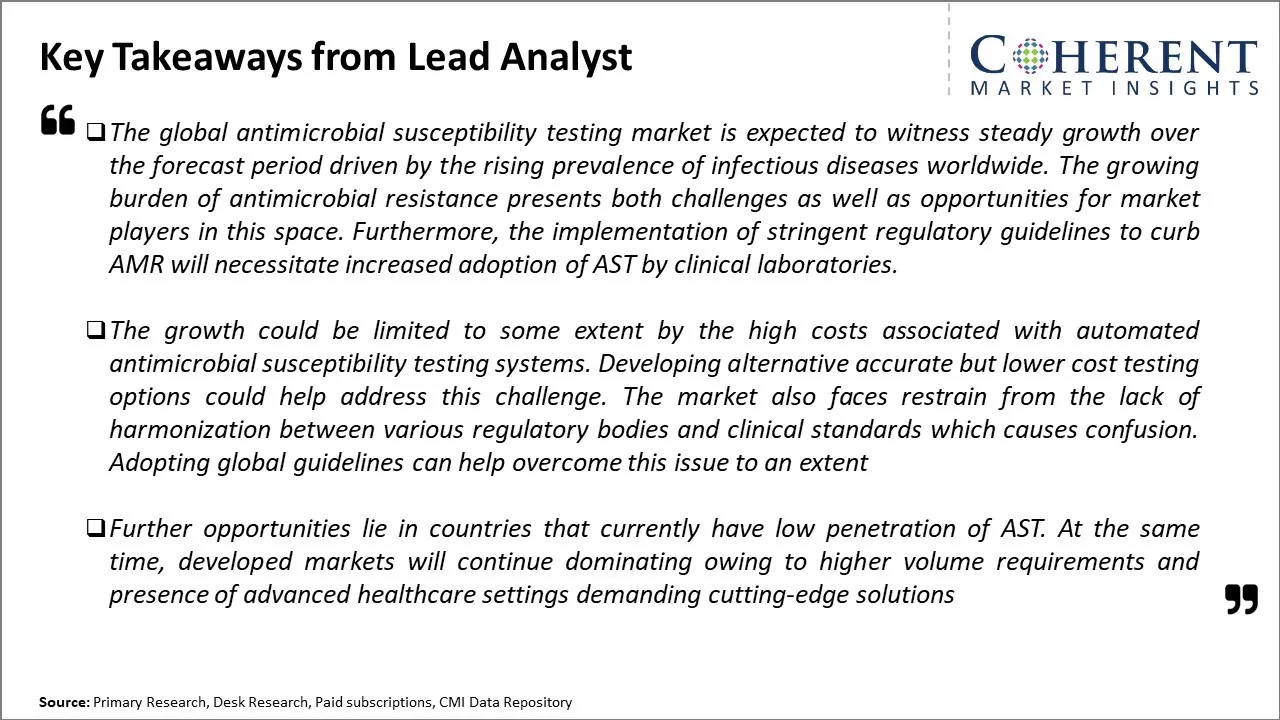
To learn more about this report, Download Free Sample
Market Challenge – High Price of Antimicrobial Susceptibility Testing SystemsAutomated antimicrobial susceptibility testing systems are equipped with highly advanced features and have high prices. The automated antimicrobial susceptibility testing systems have several advantages such as reduced detection time, accuracy of testing, and others. However, the high price of such systems may act as a restraint for the global antimicrobial susceptibility testing market growth. For instance, according to an article published by the National Center for Biotechnology Information, a series of databases relevant to biotechnology and biomedicine, in July 2020, the high price of molecular testing for antimicrobial susceptibility forms an efficient barrier for the installation of new technologies. According to the same source, testing costs also include those associated with clinical sampling and cultivation in microbiology labs, the processes that are carried out before antimicrobial susceptibility testing (AST). The roughly estimated total cost for mass spectrometry-based AST is USD 83.3(€ 79) per patient, when the cost of the MALDI-TOF device, reagents, pharmacist time, and the antimicrobial stewardship program are pooled together.
Market Opportunity – Adoption of Molecular Diagnostic Technology for antimicrobial susceptibility testing
Adoption of molecular diagnostic technology for antimicrobial susceptibility testing could provide great opportunities in the global antimicrobial susceptibility testing market. Technologies like polymerase chain reaction (PCR) and DNA microarrays allow for rapid, comprehensive, and accurate identification of pathogens as well as direct detection of resistant genes from patient samples. This enables clinicians to prescribe the most effective therapies within the day instead of waiting 2-3 days for culture-based test results.
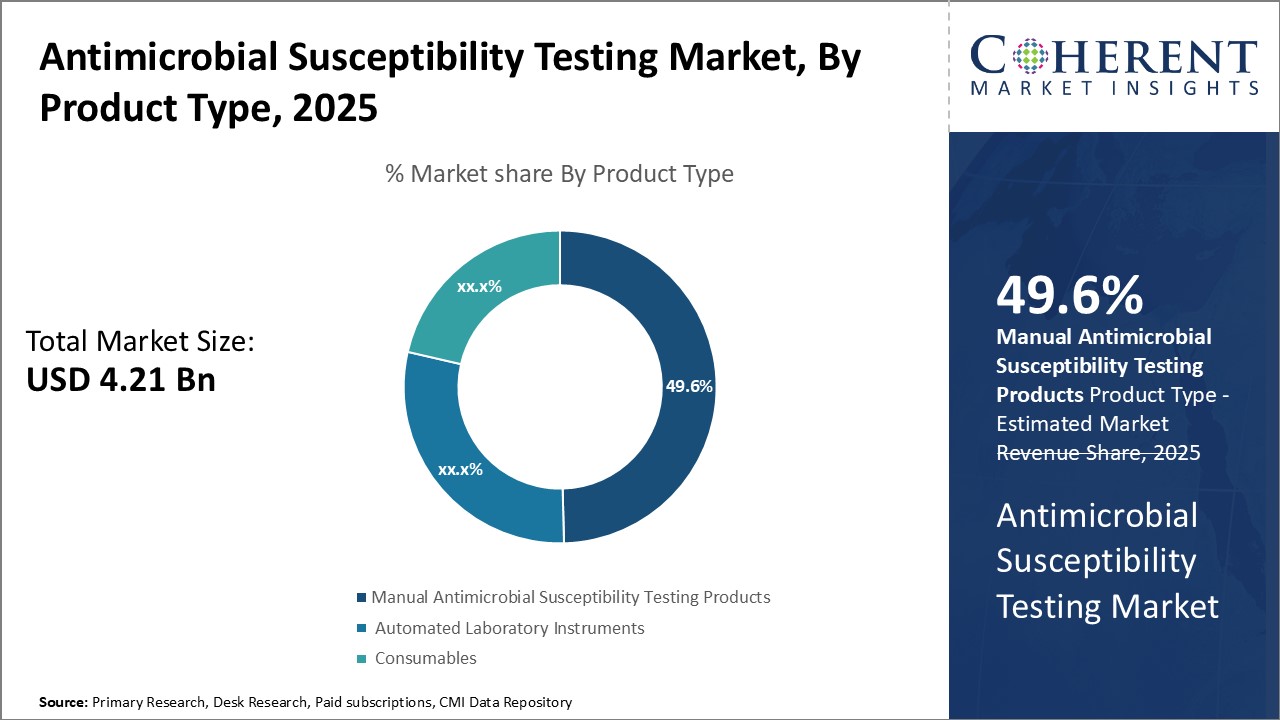
Discover high revenue pocket segments and roadmap to it: Download Free Sample
Insights, By Product Type: Access to a Wide Range of Testing Procedures and Cost-effectiveness Drive the High Adoption of ConsumablesProduct type segment is sub-segmented into manual antimicrobial susceptibility testing products, automated laboratory instruments, and consumables. The consumables sub-segment is estimated to hold 49.6% of the market share in 2025 owing to its ability to enable testing of a wide range of pathogens and being more cost-effective than automated instruments. Consumables such as culture plates, discs, cards, media, and reagents are essential for all antimicrobial susceptibility testing procedures. The versatility they offer in facilitating tests on various microbial species through standardized testing techniques makes them an indispensable part of any testing workflow. In addition, consumables represent a recurring cost for laboratories as they need to be replenished regularly, in comparison to capital equipment. This recurring nature of consumables demand contributes significantly to their large market share. Their affordability as compared to automated instruments also boosts their adoption, especially in cost-sensitive settings like small diagnostic labs and hospitals in developing regions.
Insights, By Application: High Burden of Bacterial Infections Fuels the Need for Antibacterial Susceptibility Testing
Application segment is sub-segmented into antibacterial, antifungal, anti-parasitic, and antiviral. The antibacterial sub-segment is estimated to hold 32.9% of the market share in 2025 due to the huge disease burden caused by bacterial pathogens. Antibiotic resistance has emerged as a serious threat globally with many bacterial strains becoming resistant to most available drugs. This phenomenon has significantly increased the caseload of hard-to-treat bacterial infections, necessitating effective antimicrobial susceptibility testing to optimize antibacterial treatment. The rising incidence of healthcare-associated bacterial infections and community-acquired multi-drug resistant bacteria also stimulates the demand for antibacterial susceptibility testing services.
Insights, By End User: Need for Rapid Testing and Accuracy Drives Adoption in Hospitals
End user segment is sub-segmented into hospitals, pathology/diagnostic laboratories, research and academic institutes, pharmaceutical and biotechnology companies, and contract research organizations. The hospitals sub-segment is estimated to hold 34% of the market share in 2025 owing to considerable testing volume as well as need for rapid and reliable results. In hospitals, antimicrobial susceptibility tests are crucial for deciding appropriate therapy and controlling the spread of infections. The timely administration of effective antibiotics directly influences patient outcomes. Hence, hospitals favor techniques that can yield accurate results within the shortest turnaround time like automated tools and same-day testing services. The large patient inflow and institutional infrastructure available to support high testing throughput also contribute to hospitals being the major end users.
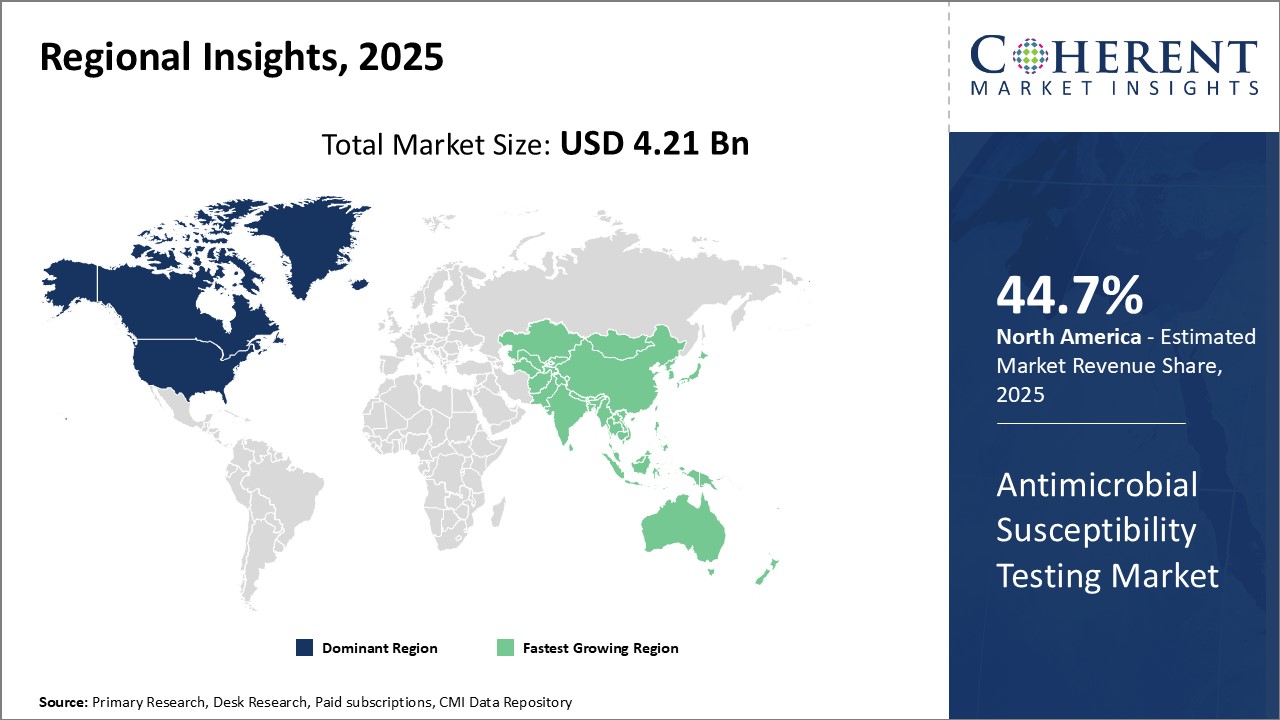
Need a Different Region or Segment? Download Free Sample
North America remains the dominant region in the global antimicrobial susceptibility testing market, and it is estimated to hold 44.7% of the market share in 2025. The presence of major market players and advanced healthcare infrastructure in the region has contributed significantly to its large market size. Countries like the U.S. have a highly developed pharmaceutical sector and increasing healthcare spending, which has translated to higher demand for diagnostic procedures like antimicrobial susceptibility testing. Moreover, rising antibiotic resistance in the region is prompting healthcare providers to frequently monitor the effectiveness of treatments, thereby driving the need for susceptibility testing services. Many leading diagnostic product manufacturers are also headquartered in North America, allowing for easy access to cutting-edge testing solutions.
The Asia Pacific region is poised to be the fastest growing market for antimicrobial susceptibility testing. Factors such as the enlarging patient population, growing medical tourism industry, and improving access to healthcare have served to strengthen the regional market in recent times. Countries like India, China, and Japan housed over half the world's population and are experiencing immense economic development. This has prompted higher government spending on modernizing their national healthcare systems. Rising affluence has also pushed citizens to spend more on their health. The expanding diagnostics industry in Asia Pacific benefits from low-cost manufacturing environments and a large skilled workforce, gaining a competitive edge in the global exports market for antimicrobial susceptibility testing tools. Local diagnostic firms are investing in R&D to cater to the indigenous demand as well as exploring overseas opportunities.
Antimicrobial Susceptibility Testing Market Report Coverage
| Report Coverage | Details | ||
|---|---|---|---|
| Base Year: | 2024 | Market Size in 2025: | USD 4.21 Bn |
| Historical Data for: | 2020 To 2024 | Forecast Period: | 2025 To 2032 |
| Forecast Period 2025 to 2032 CAGR: | 6.9% | 2032 Value Projection: | USD 6.72 Bn |
| Geographies covered: |
|
||
| Segments covered: |
|
||
| Companies covered: |
Thermo Fisher Scientific Inc., BIOMÉRIEUX, HiMedia Laboratories, Alifax S.r.l., Creative Diagnostics, Resistell AG, Danaher, BD, Merck KGaA, Bio-Rad Laboratories, Inc., Bruker, Nissui Pharmaceutical Co., Ltd., Accelerate Diagnostics, Inc., Zhuhai DL Biotech Co., Ltd., ELITechGroup, Sysmex Corporation, Copan Diagnostics Inc., and Qualigen Therapeutics, Inc. |
||
| Growth Drivers: |
|
||
| Restraints & Challenges: |
|
||
Uncover macros and micros vetted on 75+ parameters: Get instant access to report
*Definition: Lactate meters are portable devices used to measure the concentration of lactate in blood samples. They are essential tools in both medical diagnosis and athletic training, providing crucial information about an individual's physiological state. These meters typically involve the use of blood testing strips, which are inserted into the meter after a small blood sample is taken from the finger or earlobe. The meter then analyzes the lactate levels in the blood, providing a reading that can be used to assess an athlete's endurance levels, devise optimal training programs, and monitor progress over time.
Share
Share
About Author
Komal Dighe is a Management Consultant with over 8 years of experience in market research and consulting. She excels in managing and delivering high-quality insights and solutions in Health-tech Consulting reports. Her expertise encompasses conducting both primary and secondary research, effectively addressing client requirements, and excelling in market estimation and forecast. Her comprehensive approach ensures that clients receive thorough and accurate analyses, enabling them to make informed decisions and capitalize on market opportunities.
Missing comfort of reading report in your local language? Find your preferred language :
Transform your Strategy with Exclusive Trending Reports :
Frequently Asked Questions
Joining thousands of companies around the world committed to making the Excellent Business Solutions.
View All Our Clients